Beware of the ‘Hot Tub of Despair’: Terrifying pool appears harmless to the naked eye – but instantly kills almost anything that swims into it
With a name like ‘Hot Tub of Despair’, it may not surprise you to learn that this bizarre structure is more dangerous than you might first think.
While it may look like a harmless puddle of murky water to the naked eye, the Hot Tub of Despair is so deadly that almost anything that enters it dies instantly.
The 30.5-metre-wide ‘bottomless’ pond contains a toxic mix of ultra-saline water, methane and hydrogen sulfide, in which only a handful of creatures can survive.
When it was discovered in 2015, researchers found the banks littered with the preserved bodies of creatures that had tried to swim in the warm waters.
And to make matters even stranger, this pool is located more than 1,000 meters (3,300 feet) beneath the waves of the Gulf of Mexico.
This pool contains a mixture of very salty brine, which is poisonous to any animal that has the misfortune to fall into it. Note the dead crab in the pool
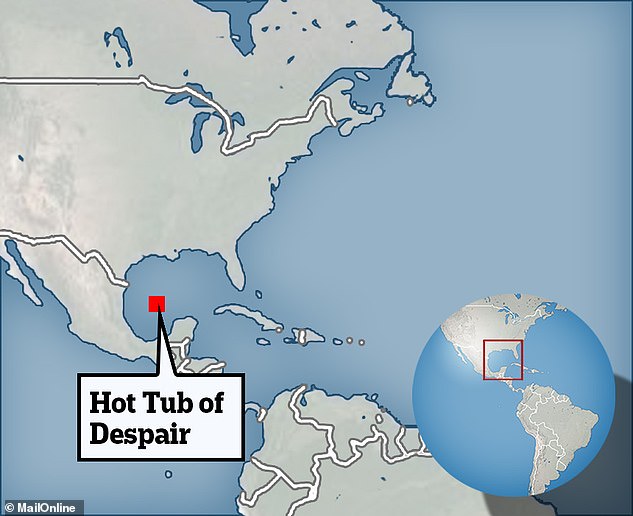
In 2015, researchers discovered a spot nicknamed the “Hot Tub of Despair,” 1,000 meters (3,300 feet) beneath the waves of the Gulf of Mexico.
The Hot Tub of Despair was discovered by the Ocean Exploration Trust as part of a survey of ‘cold seeps’ in the depths of the Gulf of Mexico.
These are areas where dense hydrocarbons, the basis for oil and gasoline, enter the water column from the seabed.
Cold seeps form over vast layers of salt that formed when ancient oceans evaporated.
As these salt layers shift and crack, they create openings that allow substances normally trapped underground to escape.
Sometimes, when these cracks form, the water deep in the sediment layers dissolves huge amounts of salt, creating a brine that is four times saltier than seawater.
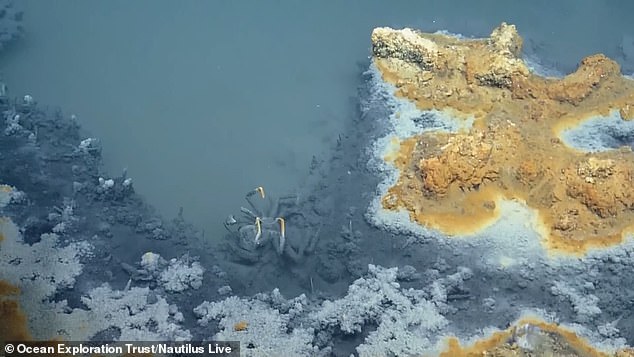
The researchers found the bodies of several crabs that had been “pickled” in the brine for so long that mineral deposits began to form on their bodies (see photo)
Because this brine is so heavy, it remains at the bottom of the ocean and cannot easily mix with the surrounding salt water.
Where salt water wells up from the ground, “brine pools” can form strange underwater lakes and ponds, such as the Hot Tub of Despair.
Operating a remotely operated vehicle called Hercules, the researchers discovered a steep, thin wall – made mainly of deposited minerals and living mussels – rising three metres above the seafloor.
They discovered that there was a 3.7-metre-thick layer of brine above a ‘bottomless’ pool of liquid mud.
Even after pulling a sampling line more than 60 feet (19 meters) into the pool, researchers could not find the bottom.
The salt water in the pool is much hotter than the surrounding area, reaching temperatures of up to 19°C (66°F), and is deadly to any large creatures that happen to fall into it, giving the pool its ominous nickname.
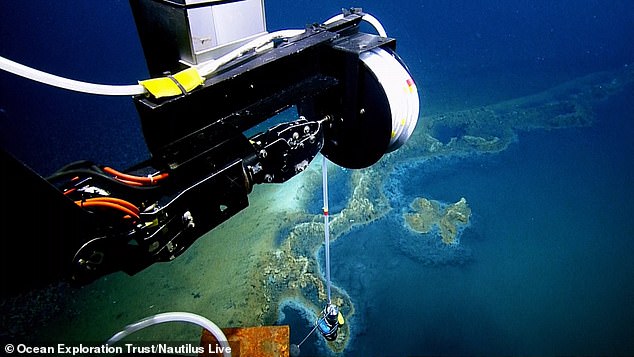
Although the brine itself is 3.7 meters deep, when the remotely operated vehicle inserted a probe (see photo), they could not find the bottom of the liquid mud layer, even after 19 meters.
The researchers discovered the bodies of several crabs and arthropods that had been ‘encrusted’ by the salt water.
Due to the high salinity levels and high concentrations of methane and hydrogen sulfide from the bubbling hydrocarbons, entering the brine bath is usually fatal.
In a video of the expedition, shared by Nautilus Live, one of the researchers says: “These kinds of larger organisms really don’t like being in this fluid.”
In one case, researchers saw the body of a large crab on top of an arthropod, both of which lay dead in the brine.
They suspected that the crab had seen the arthropod’s body in the water and followed it, hoping for an easy meal.
Without oxygen, the bacteria that normally break down bodies cannot survive.
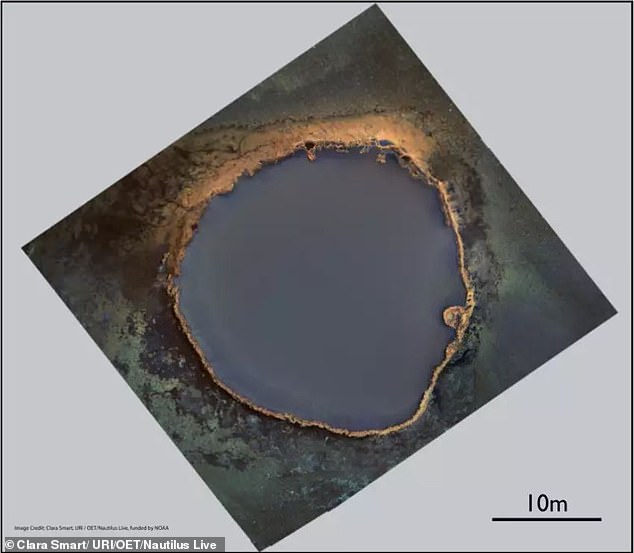
The pool was formed when layers of salt, formed by the evaporation of ancient oceans, shifted and cracked, allowing hydrocarbons and saltwater to rise from below.
Some of the bodies had been in the water so long that they were covered with a layer of mineral deposits, including large halite crystals.
The researcher added: ‘Maybe they just come here to die. They’re preserved for eternity, they’re basically embalmed here.’
But as deadly as the Hot Tub of Despair is to most creatures, there are still some life forms that can thrive in it.
The researchers even believe that living creatures are partly responsible for the creation of the pool.
A researcher said in the video: “What probably happens initially is that fluid comes up from the seafloor, and then biological communities emerge that start to use that.”
In the wall of the brine bath, the expedition team found two species of mussels that appeared to play an important role in keeping the wall intact.
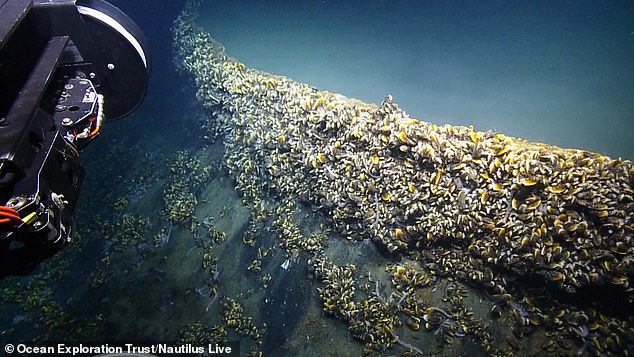
The wall of the pool is held together by a colony of mussels that thrive in the toxic water
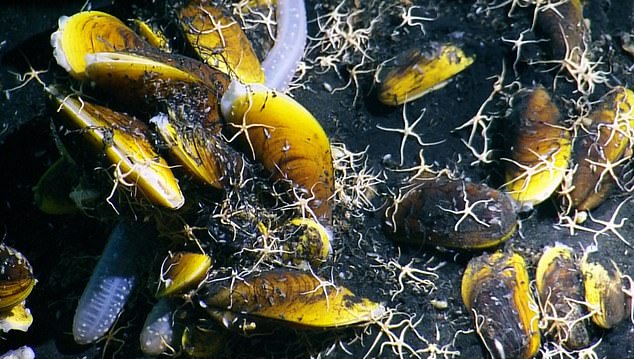
These mussels (pictured) contain bacteria in their gills that can convert dissolved gases into energy for their hosts and maintain an active ecosystem with many different species.
As the researchers note in a summary of the expedition’s findings, these mussels contain symbiotic bacteria in their gills, which convert dissolved gases into energy for their hosts.
These bacteria support a small but complex ecosystem of mussels, worms, corals and small animals in and around the deadly brine.
In a video taken by the expedition team, researchers even saw a fish repeatedly diving into the brine bath and swimming to the edge.
It has been suggested that this fish may have a tolerance to the brine and was diving into the water to feed, but the researchers noted that the fish could also simply have been sick.
The ecosystems surrounding these strange, hostile regions of our planet are vital to our scientific understanding of life.
By studying how life forms can adapt and thrive under the most extreme conditions, scientists may one day gain greater insight into the origins of life on Earth and how life may arise on distant planets.
